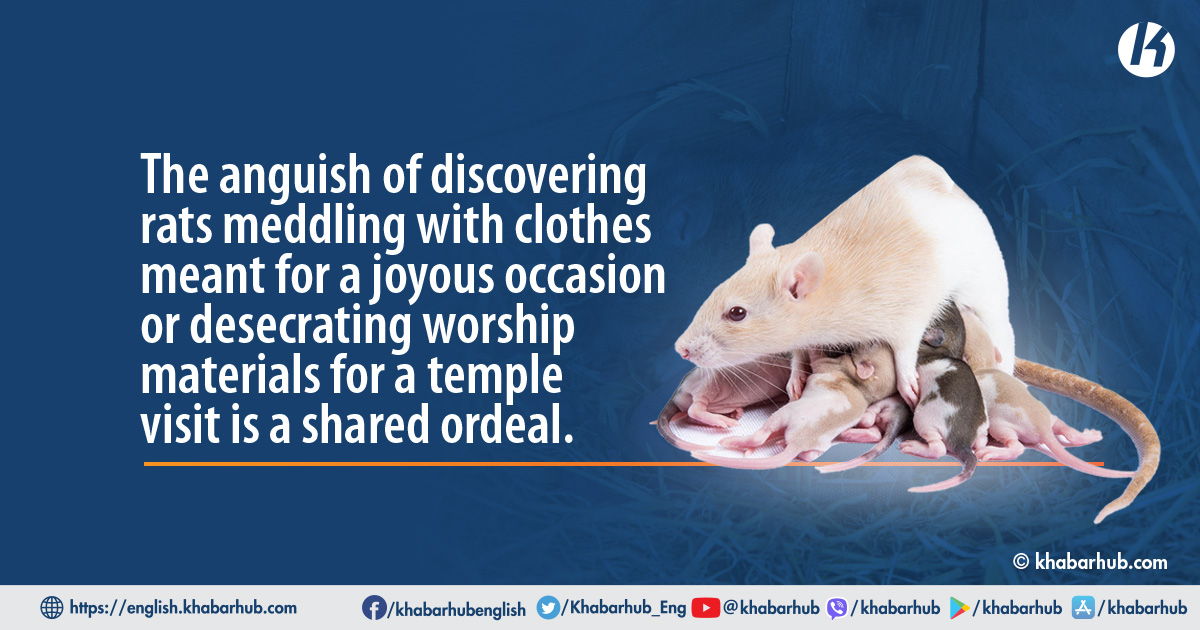Who among us hasn’t experienced the frustration of finding a mouse in the most unexpected places? How many times have we lost our composure when a shirt is pulled from the drawer, only to reveal an uninvited guest just before leaving the house?
The anguish of discovering rats meddling with clothes meant for a joyous occasion or desecrating worship materials for a temple visit is a shared ordeal.
The havoc wreaked by rodents extends beyond household items, infiltrating everything from bicycle seats to sophisticated technologies in ships, Boeing, Airbus, telecommunications, electricity, and internet services.
Globally, the havoc caused by these pests is immeasurable and transcends monetary value. Farmers face relentless challenges as rats dig up fields, pilfering from beggars’ rice stores, and wreaking havoc on clothing stored in drawers. The toll is not just on personal belongings but on economies as well.
In Nepal, an unprecedented 100 million rupees have been invested in a campaign to combat this widespread issue.
However, the battle against the rat infestation continues, with the pests outsmarting conventional efforts.
Even in November, when the focus should be on harvest celebrations, rats remain undeterred, collecting crops before farmers can, earning them the playful moniker, ‘the world’s additional harvesters in November.’ The rodents’ prolific breeding exacerbates the problem, necessitating urgent action.
A renewed, united effort has been launched in Nepal, aiming not only to control the menace but also to implement a form of ‘family planning’ for the rodent population.
Japanese scientists actively participate in this groundbreaking initiative, gaining valuable insights. Three scientists and supporting staff persistently work towards establishing a permanent family planning strategy for mice within the Kit Science Division’s two dedicated buildings.
This initiative, costing another 100 million rupees, is unparalleled globally. Yet, despite substantial investments and collective efforts, the terror of mice persists, proving that the challenge is far from being a 9 out of 10 success.
The battle against rats continues, emphasizing the need for innovative strategies to address this global predicament.
Three decades ago, the Musa family planning project was initiated with the generous support of the Japanese government.
Despite the withdrawal of the donor within six years, the government continued its commitment, annually allocating millions of dollars to sustain the mouse research program. Three Japanese employees played a pivotal role in the early stages of the project.
The Directorate of Postharvest Management, under the Department of Agriculture, reports that rats contribute to a significant four percent loss of produce due to their consumption, damage, and wastage of food.
Although current research funding is limited, the National Agriculture Research Council (NARC) is pioneering the world’s first family planning program aimed at controlling rat populations.
The approach to mouse family planning may initially seem surgical, but it can be achieved without surgery, using different types of plants.
Japanese scientists actively participate in this groundbreaking initiative, gaining valuable insights. Three scientists and supporting staff persistently work towards establishing a permanent family planning strategy for mice within the Kit Science Division’s two dedicated buildings.
In the department’s rat research program, approximately 16 pairs of rats are meticulously cared for. One building serves as the headquarters for the rodent research program, while the other houses rats in corrugated box-like containers.
Diligent staff are engaged in the daily feeding and care of the rats, providing them with wheat flakes, milk, and peanuts at a cost of Rs 200 per day, as revealed by Shivraj Chauhan, the technical officer of the rat research program.
The commitment to this endeavor is significant, with substantial expenditures on staff salaries, visits, necessary technical materials, and food for the research mice.
Furthermore, field research on mouse family planning is underway in a 1.5-hectare area at the Wheat Crop Research Center in Bhairahawa, Rupandehi.
Globally, there are nearly 2000 species of rats, with Nepal hosting 45 species. However, only five species pose a threat to humans: house mice, farm mice, large farm mice, and small farm mice, all contributing to human suffering and property damage.
The voracious appetite of rats, consuming 5/7 to 60/65 grams of food daily, results in double the waste and destruction.
A single pair of rats can produce four to 13 cubs at a time, with up to 1,500 offspring in a single summer. Remarkably, within seven days of giving birth, the female rat becomes fertile again.
Recognizing the similarities between rats and humans as mammals, the research program employs Ayurvedic drugs used in human fertility prevention for the family planning of mice.
This innovative approach aims to address the persistent challenge of rodent infestation with sustainable and humane methods.
According to the Directorate of Postharvest Management under the Department of Agriculture, rats pose a significant threat by consuming, damaging, and wasting around four percent of agricultural produce.
Beyond this economic impact, rats are also deemed hazardous to human health, as they can spread diseases, contaminate food, and harbor disease-causing bacteria and insects.
Various attempts have been made to control these harmful rodents, ranging from using poison to physical measures like beating them.
Apart from medicinal interventions, other rodent control tools include exploiting mice’s social behavior. Mice prefer living in groups, and sharing sweet, non-harmful food can invite other members of the group. Commonly favored foods for mice include fish, peanuts, ghee, and corn flour.
When these efforts proved ineffective, research turned towards a more sustainable solution—permanent family planning for mice.
However, this technology has not yet been implemented on a widespread scale among farmers. A successful trial involved administering family planning drugs to mice for a year.
The approach to mouse family planning may initially seem surgical, but it can be achieved without surgery, using different types of plants.
Similar to humans, mice’s family planning is accomplished by feeding them Ayurvedic drugs designed to prevent human fertility, as outlined in the research program.
Globally, there are nearly 2000 species of rats, with Nepal hosting 45 species. House mice, farm mice, large farm mice, and small farm mice are particularly problematic, causing various forms of suffering and damage to people.
During a year-long trial, mice fed with the powder of andi seeds showed no significant change. Meanwhile, rats consuming Gorkhamundi (Marathi) flower powder did not produce offspring while being fed but resumed reproduction after cessation of feeding. Sarifa (flour) seed powder, neem oil, and neem seed powder were found to render mice sterile.
Although the research revealed that rats did not give birth during the study, physical contact between male and female rodents remained consistent.
Currently, efforts are underway to develop a technology that reduces the reproductive capacity of rats with just one or two doses of medicine.
Scientists assert the success of this technology in laboratory settings and are preparing for testing in Bhairahawa within a few months before implementation among farmers.
Cages and traps are effective tools for rat control, but a cage trap containing a deceased rat may deter others from entering unless promptly cleaned due to the lingering smell.
Previously, continuous medication for a year was deemed necessary for family planning, but recent findings indicate that the reproductive capacity of rats can decrease significantly with only one or two doses.
Apart from medicinal interventions, other rodent control tools include exploiting mice’s social behavior. Mice prefer living in groups, and sharing sweet, non-harmful food can invite other members of the group. Commonly favored foods for mice include fish, peanuts, ghee, and corn flour.
Rat holes, typically about a meter across, play a crucial role in their behavior. While a rat may need at least two doors for a house in the middle of the hole, they consistently use the same path.
Interestingly, other rats tend to avoid areas where a group member is affected or where a rat has died, showcasing their keen sense of smell.
Various methods, ranging from homegrown plants to modern pesticides, are employed to combat rat infestations.
One effective approach involves kneading hemp seeds and curry leaves into wheat flour, forming pills that can be strategically placed where rats roam and feed. Similarly, positioning alum in areas frequented by mice prompts them to flee due to the off-putting smell.
Mice exhibit a strong aversion to places where a group member is affected or where one has died, showcasing their keen sense of smell.
Live capture of a mouse, followed by dyeing and release in the same area, induces fear in other mice, prompting them to retreat.
This historical episode resonates with contemporary challenges faced by farmers in countries like China, India, the Soviet Union, Bangladesh, and Vietnam, where rat-induced losses on agricultural crops are deemed irreparable.
Cages and traps are effective tools for rat control, but a cage trap containing a deceased rat may deter others from entering unless promptly cleaned due to the lingering smell.
In cases of poisoning, it is advised to alternate between non-poisoned and poisoned food for three consecutive days, introducing poisoned food on the fourth day.
Gum plates, fumigation, water spraying, and the strategic placement of pipes for mice entry are additional methods employed for mouse control.
Keeping a cat at home is also a natural deterrent; however, scientists caution against providing food to the cat in the evening to ensure its efficacy in controlling mice.
The Extinction Threat of Rats: A Lesson from Easter Island
Rapanui, or Easter Island, situated in the middle of the Indian Ocean, is considered the most remote island globally, with a history dating back to Polynesian habitation between 700 and 800 AD.
The island boasts the Bhimkaya Moai statues, erected by Polynesian aborigines in memory of their ancestors.
While the history of Rapanui is fascinating, its environmental degradation serves as a tragic cautionary tale for humanity.
Anthropologists attribute the island’s ecological devastation to rats, which reached a staggering 20 million on the 163 square kilometer island by 1300, as reported in 2005.
These rats decimated over 16 million palm trees by consuming palm seeds, leading to severe ecological consequences.
Anthropologist Terry Hunt of the University of Hawai’i notes that the absence of larger animals on the small island allowed the rat population to flourish, ultimately contributing to the extinction of the Rapanui civilization.
This historical episode resonates with contemporary challenges faced by farmers in countries like China, India, the Soviet Union, Bangladesh, and Vietnam, where rat-induced losses on agricultural crops are deemed irreparable.
The tale of Easter Island serves as a stark reminder of the potential consequences of unchecked rat populations on civilization and the environment.








Comment